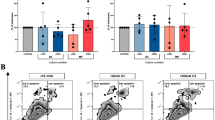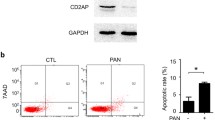Abstract
Minimal change disease (MCD), the most common idiopathic nephrotic syndrome in children, is characterized by proteinuria and loss of glomerular visceral epithelial cell (podocyte) ultrastructure. Lipopolysaccharide (LPS) and puromycin aminonucleoside (PAN) are used to study podocyte injury in models of MCD in vivo and in vitro. We hypothesized that LPS and PAN influence components of the innate immune system in podocytes such as the Toll-Like Receptor (TLRs), TLR adapter molecules, and associated cytokines. Our results show that cultured human podocytes constitutively express TLRs 1–6 and TLR-10, but not TLRs 7–9. LPS (25 μg/ml) or PAN (60 μg/ml) caused comparable derangement of the actin cytoskeleton in podocytes. Quantitative RT-PCR analysis show that LPS differentially up-regulated the expression of genes for TLRs (1 > 4 ≥ 2 > 3 > 6 > 5), the adapter molecule, MyD88, and transcription factor NF-κB within one hour. LPS also caused increased levels of IL-6, IL-8 and MCP1 without exerting any effect on TNF-α, IFN-α or TGF-β1 at 24 h. Immunofluorescence intensity analysis of confocal microscopy images showed that LPS induced a significant increase in nuclear translocation of NF-κB by 6 h. In contrast, PAN-induced only small changes in the expression of TLRs 2–6 that included a persistent increase in TLRs 2 and 5, a transient increase in TLR-4, and a gradual increase in TLRs 3 and 6 between 1 and 6 h. Correspondingly, it did not alter pro-inflammatory cytokine levels in podocytes. However, PAN induced a low but significant increase in NF-κB nuclear translocation within one hour that remained unchanged up to 6 h. In summary, these novel findings show that LPS, a known TLR-4 ligand, induced the gene expression of multiple TLRs with maximum effect on the expression of TLR-1 suggesting a loss of receptor selectivity and induction of receptor interactions in podocytes. A comparable derangement of the podocyte cytoskeleton and significant increase in the nuclear translocation of NF-κB by PAN suggest that disparate but complementary mechanisms may contribute to the development of podocytopathy in MCD.





Similar content being viewed by others
References
Adeline M, Hajjar D, O’Mahony S, Ozinsky A, Underhill DM, Aderem A, Klebanoff SJ, Wilson CB (2001) Functional interactions between Toll-Like Receptor (TLR) 2 and TLR1 or TLR6 in response to phenol-soluble modulin. J Immunol 166:15–19
Anders HJ, Schlöndorff D (2007) Toll-like receptors: emerging concepts in kidney disease. Curr Opin Nephrol Hypertens 16:177–83
Araya CE, Wasserfall CH, Brusko TM, Mu W, Segal MS, Johnson RJ et al (2006) A case of unfulfilled expectations. Cytokines in idiopathic minimal lesion nephrotic syndrome. Pediatr Nephrol 21:603–610
Banas MC, Banas B, Hudkins KL, Wietecha TA, Iyoda M, Bock E et al (2008) TLR4 links podocytes with the innate immune system to mediate glomerular injury. J Am Soc Nephrol 19:704–713
Brown HJ, Lock HR, Wolfs TG, Buurman WA, Sacks SH, Robson MG (2007) Toll-like receptor 4 ligation on intrinsic renal cells contributes to the induction of antibody-mediated glomerulonephritis via CXCL1 and CXCL2. J Am Soc Nephrol 18:1732–1739
Carmody RJ, Chen YH (2007) Nuclear factor-kappaB activation and regulation during toll-like receptor signaling. Cell Mol Immunol 4:31–41
Coers W, Huitema S, van der Horst ML, Weening JJ (1994) Puromycin aminonucleoside and adriamycin disturb cytoskeletal and extracellular matrix protein organization, but not protein synthesis of cultured glomerular epithelial cells. Exp Nephrol 2:40–50
Couser WG (2012) Basic and translational concepts of immune-mediated glomerular disease. J Am Soc Nephrol 23:381–399
Diamond JR, Bonventre JV, Karnovsky MJ (1986) A role for oxygen free radicals in aminonucleoside nephrosis. Kidney Int 29:478–483
Ding X, Zhu F, Li T, Zhou Q, Hou FF, Nie J (2011) Numb protects renal proximal tubular cells from puromycin aminonucleoside-induced apoptosis through inhibiting Notch signaling pathway. Int J Biol Sci 7:269–278
Farhat K, Riekenberg S, Heine H, Debarry J, Lang R, Mages J et al (2008) Heterodimerization of TLR2 with TLR1 or TLR6 expands the ligand spectrum but does not lead to differential signaling. J Leukoc Biol 83:692–701
Frenk S, Antonowicz I, Craig JM, Metcoff J (1955) Experimental nephrotic syndrome induced in rats by aminonucleoside; renal lesions and body electrolyte composition. Proc Soc Exp Biol Med 89:424–427
Gloy J, Reitinger S, Fischer K–G, Schreiber R, Boucherot A, Kunzelmann K et al (2000) Amino acid transport in mouse podocytes. Am J Physiol 278:F999–F1005
Greiber S, Müller B, Daemisch P, Pavenstädt H (2002) Reactive oxygen species alter gene expression in podocytes: induction of granulocyte macrophage-colony-stimulating factor. J Am Soc Nephrol 13:86–95
Gribar SC, Richardson WM, Sodhi CP, Hackam DJ (2008) No longer an innocent bystander: epithelial toll-like receptor signaling in the development of mucosal inflammation. Mol Med 14:645–659
Ishimoto T, Shimada M, Araya CE, Huskey J, Garin EH, Johnson RJ (2011) Minimal Change Disease: A CD80 podocytopathy? Semin Nephrol 31:320–325
Kistler AD, Reiser J (2010) Maximal ‘CD80-uria’ with minimal change. Kidney Int 78:236–238
Lane JC, Kaskel FJ (2009) Pediatric nephrotic syndrome: from the simple to the complex. Semin Nephrol 29:389–398
Lannigan R (1963) The production of chronic renal disease in rats by a single intravenous injection of aminonucleoside of puromycin and the effect of low dosage continuous hydrocortisone. Br J Exp Pathol 44:326–333
MacDonald NE, Wolfish N, McLaine P, Phipps P, Rossier E (1986) Role of respiratory viruses in exacerbations of primary nephrotic syndrome. J Pediatr 108:378–382
Marshall CB, Pippin JW, Krofft RD, Shankland SJ (2006) Puromycin aminonucleoside induces oxidant-dependent DNA damage in podocytes in vitro and in vivo. Kidney Int 70:1962–1973
Mathieson PW (2007) Minimal change nephropathy and focal segmental glomerulosclerosis. Semin Immunopathol 29:415–426
Matsumoto M, Funami K, Tanabe M, Oshiumi H, Shingai M, Seto Y et al (2003) Subcellular localization of Toll-like receptor 3 in human dendritic cells. J Immunol 171:3154–62
McCarthy ET, Sharma R, Sharma M, Li JZ, Ge X, Dileepan KN et al (1998) Tumor Necrosis Factor-α increases albumin permeability of isolated rat glomeruli through the generation of superoxide. J Amer Soc Nephrol 9:433–438
Medzhitov R, Preston-Hurlburt P, Janeway CA Jr (1997) A human homologue of the Drosophila Toll protein signals activation of adaptive immunity. Nature 388:394–397
Neuhaus TJ, Fay J, Dillon MJ, Trompeter RS, Barratt TM (1994) Alternative treatment to corticosteroids in steroid sensitive idiopathic nephrotic syndrome. Arch Dis Child 71:522–526
Nishiya T, DeFranco AL (2004) Ligand-regulated chimeric receptor approach reveals distinctive subcellular localization and signaling proper ties of the Toll-like receptors. J Biol Chem 279:19008–19017
Ospelt C, Gay S (2010) TLRs and chronic inflammation. Int J biochem Cell Biol 42:495–505
Pawar RD, Castrezana-Lopez L, Allam R, Kulkarni OP, Segerer S, Radomska E et al (2009) Bacterial lipopeptide triggers massive albuminuria in murine lupus nephritis by activating Toll-like receptor 2 at the glomerular filtration barrier. Immunology 128(1 Suppl):e206–221
Pippin JW, Brinkkoetter PT, Cormack-Aboud FC, Durvasula RV, Hauser PV, Kowalewska J et al (2009) Inducible rodent models of acquired podocyte diseases. Am J Physiol Renal Physiol 296:F213–229
Reiser J, von Gersdorff G, Loos M, Oh J, Asanuma K, Giardino L et al (2004) Induction of B7-1 in podocytes is associated with nephrotic syndrome. J Clin Invest 113:1390–1397
Saha TC, Singh H (2006) Minimal Change Disease: A Review. Southern Med J 99:1264–1270
Saleem MA, O’Hare MJ, Reiser J, Coward RJ, Inward CD, Farren T et al (2002) A conditionally immortalized human podocyte cell line demonstrating nephrin and podocin expression. J Am Soc Nephrol 13:630–638
Sanchez-Niño MD, Benito-Martin A, Gonçalves S, Sanz AB, Ucero AC, Izquierdo MC et al (2010) TNF superfamily: a growing saga of kidney injury modulators. Mediators Inflamm. doi:10.1055/2010/182958
Savin VJ, Sharma M, McCarthy ET, Sharma R, Reddy S, Dong JW et al (2008) Cardiotrophin like cytokine-1: Candidate for the focal glomerular sclerosis permeability factor. J Am Soc Neph 19:59A
Sellier-Leclerc AL, Duval A, Riveron S, Macher MA, Deschenes G, Loirat C et al (2007) A humanized mouse model of idiopathic nephrotic syndrome suggests a pathogenic role for immature cells. J Am Soc Nephrol 18:2732–2739
Shiiki H, Sasaki Y, Nishino T, Kimura T, Kurioka H, Fujimoto S et al (1998) Cell proliferation and apoptosis of the glomerular epithelial cells in rats with puromycin aminonucleoside nephrosis. Pathobiology 66:221–229
Shimada M, Araya C, Rivard C, Ishimoto T, Johnson RJ, Garin EH (2011) Minimal change disease: a “two-hit” podocyte immune disorder? Pediatr Nephrol 26:645–649
Shimada M, Ishimoto T, Lee PY, Lanaspa MA, Rivard CJ, Roncal-Jimenez CA et al (2012) Toll-like receptor 3 ligands induce CD80 expression in human podocytes via an NF-{kappa}B-dependent pathway. Nephrol Dial Transplant 27:81–89
Smoyer WE, Ransom RF (2002) Hsp27 regulates podocyte cytoskeletal changes in an in vitro model of podocyte process retraction. FASEB J 16:315–326
Spitzer JH, Visintin A, Mazzoni A, Kennedy MN, Segal DM (2002) Toll-like receptor 1 inhibits Toll-like receptor 4 signaling in endothelial cells. Eur J Immunol 32:1182–1187
Srivastava T, Simon SD, Alon US (1999) High incidence of focal segmental glomerulosclerosis in nephrotic syndrome of childhood. Pediatr Nephrol 13:13–18
Srivastava T, McCarthy ET, Sharma R, Cudmore PA, Sharma M, Johnson ML et al (2010) Prostaglandin E2 is crucial in the response of podocytes to fluid flow shear stress. J Cell Commun Signal 4:79–90
Sun Y, He L, Takemoto M, Patrakka J, Pikkarainen T, Genové G, Norlin J et al (2009) Glomerular transcriptome changes associated with lipopolysaccharide-induced proteinuria. Am J Nephrol 29:558–570
Suranyi MG, Guasch A, Hall BM, Myers BD (1993) Elevated levels of tumor necrosis factor-alpha in the nephrotic syndrome in humans. Am J Kidney Dis 21:251–259
Suzuki T, Takemura H, Noiri E, Nosaka K, Toda A, Taniguchi S et al (2001) Puromycin aminonucleoside induces apoptosis and increases HNE in cultured glomerular epithelial cells. Free Radic Biol Med 31:615–623
Takeda K, Akira S (2004) TLR signaling pathways. Sem Immunol 16:3–9
Tipping PG (2008) Are podocytes passive or provocative in proteinuric glomerular pathology? J Am Soc Nephrol 19:651–653
Van Den Berg JG, Aten J, Chand MA, Claessen N, Dijkink L et al (2000) Interleukin-4 and interleukin-13 act on glomerular visceral epithelial cells. J Am Soc Nephrol 11:413–422
Walia D, Sharma M, Raveendran V, Zhou J, Sharma R, Stechschulte DJ et al (2012) Human Mast Cells (HMC-1 C56) Enhance Interleukin-6 production by quiescent and lipopolysaccharide-stimulated human coronary artery endothelial cells. Mediators Inflamm. doi:10.1155/2012/274347
Wasilewska A, Zoch-Zwierz W, Taranta-Janusz K, Kołodziejczyk Z (2011) Urinary monocyte chemoattractant protein-1 excretion in children with glomerular proteinuria. Scand J Urol Nephrol 45:52–59
Woroniecki RP, Shatat IF, Supe K, Du Z, Kaskel FJ (2008) Urinary cytokines and steroid responsiveness in idiopathic nephrotic syndrome of childhood. Am J Nephrol 28:83–90
Yamamoto M, Sato S, Hemmi H, Uematsu S, Hoshino K, Kaisho T et al (2003) TRAM is specifically involved in the Toll-like receptor 4-mediated MyD88-independent signaling pathway. Nat Immunol 4:1144–1150
Yap HK, Cheung W, Murugasu B, Sim SK, Seah CC, Jordan SC (1999) Th1 and Th2 cytokine mRNA profiles in childhood nephrotic syndrome: evidence for increased IL-13 mRNA expression in relapse. J Am Soc Nephrol 10:529–537
Yew KH, Carsten B, Harrison C (2010) Scavenger receptor A1 is required for sensing HCMV by endosomal TLR-3/-9 in monocytic THP-1 cells. Mol Immunol 47:883–893
Zarember KA, Godowski PJ (2002) Tissue expression of human Toll-like receptors and differential regulation of Toll-like receptor mRNAs in leukocytes in response to microbes, their products, and cytokines. J Immunol 168:554–561
Acknowledgements
The work was supported by The Paul Henson Endowed Fund for Pediatric Research and The Sam and Helen Kaplan Research Fund in Pediatric Nephrology. We thank Ashley Sherman, M.A. for assistance in statistical analysis. Parts of the work were presented at the XVth Congress of the International Pediatric Nephrology Association, New York, 30th August 2010.
Conflict of interest
None
Author information
Authors and Affiliations
Corresponding author
Rights and permissions
About this article
Cite this article
Srivastava, T., Sharma, M., Yew, KH. et al. LPS and PAN-induced podocyte injury in an in vitro model of minimal change disease: changes in TLR profile. J. Cell Commun. Signal. 7, 49–60 (2013). https://doi.org/10.1007/s12079-012-0184-0
Received:
Accepted:
Published:
Issue Date:
DOI: https://doi.org/10.1007/s12079-012-0184-0




